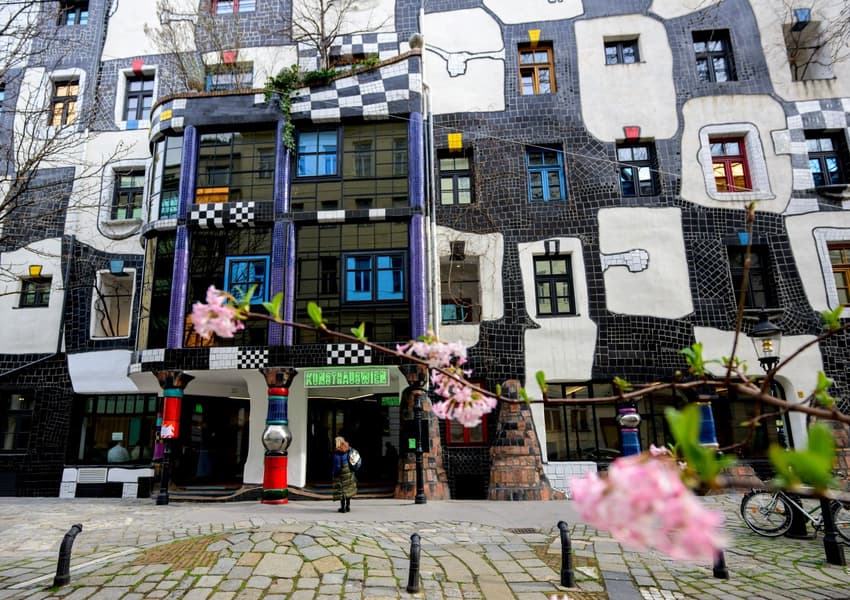Vienna's wacky Hundertwasser museum gets even greener

Friedensreich Hundertwasser would have no doubt approved. Austria has made its "first green museum" -- entirely dedicated to the work of the maverick artist and ecological trailblazer -- even greener.
The colourful Kunst Haus Wien in Vienna has ditched fossil fuels for an entirely renewable in-house hydrothermal energy system using a well in its courtyard.
The museum -- where Hundertwasser used to stay on the top floor -- draws more than a hundred thousand visitors a year, with the nearby and equally zany Hundertwasser House attracting more than a million.
Curators believe the polymath, who designed a series of environmentally friendly buildings in Austria and abroad, would have approved of the €3.5 million ($3.8-million) green makeover of the gallery.
Renovating the building according to the latest environmental standards was an attempt to live up to his reputation as a green prophet, said director Gerlinde Riedl, who called it the country's "first green museum".
Hundertwasser oversaw the opening of the museum in 1991 -- which holds the world's largest collection of his work -- after transforming the abandoned factory "according to his aesthetic ideals into a unique piece of art," curator Andreas Hirsch told AFP as the new permanent exhibition opened.
The artist described himself as a "doctor" repairing "sick" buildings to achieve harmony with nature.
In one of his manifestos he railed against "rationalism in architecture", declaring that "the straight line is godless".
Naked protests
Born Friedrich Stowasser in Vienna in 1928 to a Jewish mother, Hundertwasser managed to survive the Nazis by passing himself off as a member of the Hitler Youth, wearing the swastika armband "as protection".
Almost 70 family members perished in the Holocaust. He later changed his name to Friedensreich Hundertwasser -- meaning "Kingdom of peace, 100 waters" in German. Having suffered such tragedy, he was all the more eager "to achieve something great", said Hirsch, who wrote two books on the artist.
Hundertwasser designed more than 30 architectural projects all over the world including incinerators, thermal baths and toilets.
Starting out as a painter, he developed an almost obsessive interest in spiral forms.
Impossible to categorise, he wore mismatching socks and gave speeches naked to protest against modern cities.
"From the early 1950s, he had very strict ecological thoughts, and opposed cities full of concrete and tarmac," Hirsch said.
An early advocate of recycling, Hundertwasser "reused everything", telling his students "never to throw away any pigments, colours, papers", the expert added.
Hundertwasser lived frugally and designed his own composting toilets to save water.
He was still painting, "earning his passage" to his adopted homeland New Zealand on the Cunard liner Queen Elizabeth 2 -- having not wanted to fly -- when he died of a heart attack at 71.
He was buried there under a tulip tree he planted himself.
Comments
See Also
The colourful Kunst Haus Wien in Vienna has ditched fossil fuels for an entirely renewable in-house hydrothermal energy system using a well in its courtyard.
The museum -- where Hundertwasser used to stay on the top floor -- draws more than a hundred thousand visitors a year, with the nearby and equally zany Hundertwasser House attracting more than a million.
Curators believe the polymath, who designed a series of environmentally friendly buildings in Austria and abroad, would have approved of the €3.5 million ($3.8-million) green makeover of the gallery.
Renovating the building according to the latest environmental standards was an attempt to live up to his reputation as a green prophet, said director Gerlinde Riedl, who called it the country's "first green museum".
Hundertwasser oversaw the opening of the museum in 1991 -- which holds the world's largest collection of his work -- after transforming the abandoned factory "according to his aesthetic ideals into a unique piece of art," curator Andreas Hirsch told AFP as the new permanent exhibition opened.
The artist described himself as a "doctor" repairing "sick" buildings to achieve harmony with nature.
In one of his manifestos he railed against "rationalism in architecture", declaring that "the straight line is godless".
Naked protests
Born Friedrich Stowasser in Vienna in 1928 to a Jewish mother, Hundertwasser managed to survive the Nazis by passing himself off as a member of the Hitler Youth, wearing the swastika armband "as protection".
Almost 70 family members perished in the Holocaust. He later changed his name to Friedensreich Hundertwasser -- meaning "Kingdom of peace, 100 waters" in German. Having suffered such tragedy, he was all the more eager "to achieve something great", said Hirsch, who wrote two books on the artist.
Hundertwasser designed more than 30 architectural projects all over the world including incinerators, thermal baths and toilets.
Starting out as a painter, he developed an almost obsessive interest in spiral forms.
Impossible to categorise, he wore mismatching socks and gave speeches naked to protest against modern cities.
"From the early 1950s, he had very strict ecological thoughts, and opposed cities full of concrete and tarmac," Hirsch said.
An early advocate of recycling, Hundertwasser "reused everything", telling his students "never to throw away any pigments, colours, papers", the expert added.
Hundertwasser lived frugally and designed his own composting toilets to save water.
He was still painting, "earning his passage" to his adopted homeland New Zealand on the Cunard liner Queen Elizabeth 2 -- having not wanted to fly -- when he died of a heart attack at 71.
He was buried there under a tulip tree he planted himself.
Join the conversation in our comments section below. Share your own views and experience and if you have a question or suggestion for our journalists then email us at [email protected].
Please keep comments civil, constructive and on topic – and make sure to read our terms of use before getting involved.
Please log in here to leave a comment.